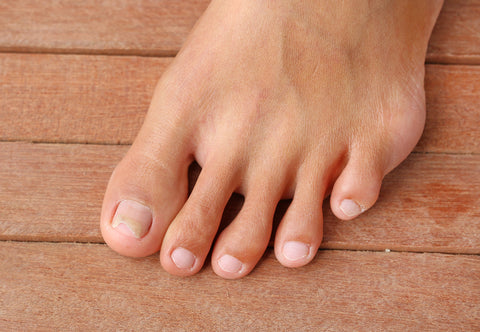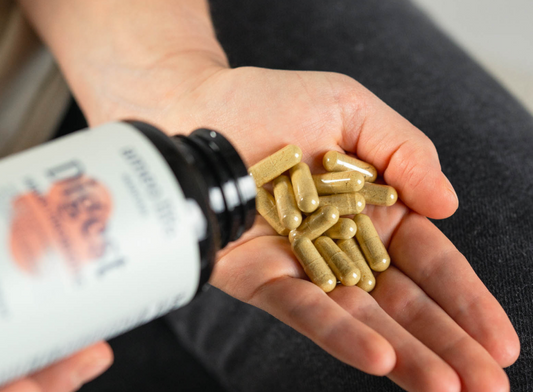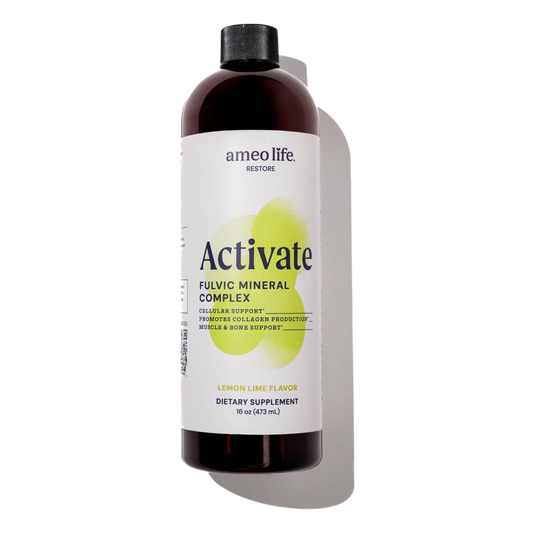What You May Not Know About Toe Fungus

What do you think of when you hear the phrase toe fungus?
No, toenail fungus is not like that fuzzy white stuff growing on the leftovers you forgot about in the fridge...
The mushrooms sprouting up in the yard after a rainy spell? Whatever pops into your mind, it probably isn’t smelly yellow toenail fungus.
There are an estimated 5.1 million fungal species in existence on Earth. And they take on some very different appearances. We also dive into a super hero product that can help right away start safely cleansing the skin from bad bacteria while protecting the good!
Roles of Fungi
Fungi play a role in both food and toxins, healing and illness. The rare edible fungus known as a truffle is a delicacy that can cost anywhere from $250 to $4,000 a pound… unless there’s a shortage, in which case those figures can escalate drastically. Yet, pick the wrong mushroom from among the wild varieties, and you could be in for a hospital stay…
Penicillium
Single-celled species resembling yeast inhabit fluffy baked breads and fermented beverages. Another species of fungi, Penicillium, is famous for its life-saving antibiotic properties.
And then there’s nail fungus, officially known as onychomycosis… a fungal infection under and/or around the nails, especially toenails.
Toenail fungus is ugly. It thickens, distorts, and discolours the nails. It can be painful, and it can stink.
What is Toe Fungus?

Toenail fungus is an infection caused by one of several species of fungus. The three main types that affect the toenails are described below.
Dermatophytes
The most common culprits are dermatophytes. Dermatophytes are a group of fungi that infect tissues containing keratin… skin, hair, and nails.
This is the same type of fungus that usually causes athlete’s foot. It infects the skin around the nail bed, often working its way under the nail.
The nail may thicken, turn yellow or white, and may break apart separating from the skin underneath.
Dead skin and broken nail fragments often collect under the nails. It can be uncomfortable and even painful, especially when shoes apply pressure to thickened and/or damaged nails.
Ways Toe Fungus Can Appear
Nail fungus can also appear as superficial white spots on the nail that spread across and cover it with a chalky, powder-like layer. Because it stays on the top surface of the nail, it is easier to treat than other forms.
Another type of nail fungus is caused by a form of yeast, or Candida. It is more likely to be seen on fingernails and can also discolour and deform the nail, getting under and around the nails. Candida infections in the nails can be sore and inflamed, showing more obvious signs of infection.
Who is at Risk?
Anyone can serve as a host to toenail fungus. But some conditions put certain people at a higher risk than others. Among these are:
- Diabetes – the hyperglycaemia, reduced immune function, and poor circulation associated with diabetes all play a role in increasing the risk of fungal infections in diabetics. Candida albicans, which can be a culprit in toenail fungus, is especially prevalent in diabetics.
- Circulation problems – older people, or anyone who has reduced circulation is at a greater risk.
- Weak immune system – people with immune systems that have been weakened by other illnesses or conditions have an increased risk of fungal infections.
- Skin condition – conditions like psoriasis or injuries on or around the nails can create the right environment for fungal growth.
- Sweaty feet/damp shoes and socks – people whose feet stay moist from sweat for long periods of time are also providing the perfect environment for fungi to thrive.
- Locker rooms and/or pools – going barefoot can provide great health benefits… just as long as it is not in an area where other people, who may be carrying fungus, are doing the same thing.
- Adult men – men get more toenail infections than women. Although admittedly, this is more of a statistic than a risk factor and could simply be due to the fact that men tend to wear closed-toe shoes and sweat more.
Not all the factors above are within your control, but others certainly are. With some care and diligence, everyone - even people in higher risk groups - can give themselves an advantage.
How to Tell if You Have a Fungal Nail Infection
What kind of clues should you look for if you suspect a toenail fungus? Here are some things that might indicate a fungal infection:
 Discoloured nails – white spots, or yellow, brown, or green-looking nails can indicate fungal infection. This could be within the nail, or the colour may be coming from under the nail.
Discoloured nails – white spots, or yellow, brown, or green-looking nails can indicate fungal infection. This could be within the nail, or the colour may be coming from under the nail.- Misshapen nails – nail fungus can cause the surface of nails to become distorted.
- Thickened nails – infected nails may become thicker leading to pain or discomfort when wearing shoes.
- Brittle nails – nails may break easily and seem to be dry and brittle. Edges may be jagged.
- Nails detach from nail bed – fungus and debris, which may look like dry skin, can build-up under the nails and cause them to lift up or detach from the skin under the nails.
- Slight odor – an unusual odor may indicate a fungal infection.
The only way to know for sure if you have a toenail fungus is to see a doctor. Th
ey’ll take a sample of nail clippings or debris from under the nails and send it off to a lab to determine if it is fungal, and identify the exact type of infection.
Diabetics should always talk to their doctor, as an infection can have very serious health implications.
Prevention is Key with Toe Fungus
Prevention is always preferable to having to
treat a condition once it has set in. Toenail fungus is much easier to prevent than it is to get rid of.
That’s because the nail itself shields the place where the fungus is residing… it can prevent the treatment from reaching it.
- Keep nails dry. The first step inpreventing toenail fungus is to wear clean, dry shoes and reduce the amount of time that your feet stay in moist socks. Changing damp socks regularly, wearing shoes made of natural, breathable materials, and alternating shoes so they can have a day to dry out between each wearing will also help.
- Wear footwear in public places. As important as it is to allow the feet to breathe, it’s equally vital to keep them off the bare floor when you’re in the locker room, public pool, or other public facility. A pair of waterproof or rubber sandals will serve the purpose well.
- Follow proper hygiene practices. When you trim toenails, go straight across and use a file to smooth the edges. Any nails that have thickened can be filed down as well. Use some moisturizer to help keep them from drying out. And if you go to a nail salon, ask what their protocol is for sanitizing tools.
- Let them breathe. If you paint your nails, it’s also important to give them a breather every now and then… nail polish and artificial nails (although unlikely on toenails - but fingernails can get fungal infections, too) don’t allow for any air circulation so moisture gets trapped underneath.
The organisms that cause toenail fungus can also cause the itchy, sometimes painful fungal infection known as athlete’s foot. When the feet are stuck in warm, moist shoes all day, the conditions are perfect for the fungus to spread to the surrounding skin, usually between the toes.
Clean and Sanitize to Prevent Reinfection
Often people have a hard time keeping the fungus away. They may get rid of it only to have it reappear soon afterward.
Be sure to clean and sanitize any and all tools used to trim and clean the nails and nail beds. Clean with soap and water and then sanitize with isopropyl (rubbing) alcohol, 30 percent bleach and water solution, or a barber or hospital grade disinfectant. The sanitizer should remain in contact with the tools for at least three minutes before allowing them to dry. And of course, wash and dry your hands.
Remember that shoes, socks, towels, and hard surfaces can harbour the fungus. Be diligent about cleanliness and keeping the feet dry.
Silver liquid can be sprayed in shoes or on surfaces as well to assist in disinfection.
Over the Counter and Prescription Anti-fungals
There are a number of over-the-counter anti fungal treatments available. They contain different active ingredients such as fluconazole, terbinafine hydrochloride, or clotrimazole, and some will be more effective than others. However, none will work if they don’t reach the source of the infection… the fungus.
This is why oral drugs are prescribed for toe fungus. Oral medications include griseofulvin, itraconazole, and terbinafine, and they tend to be more effective than over-the-counter topical products because topicals don’t reach the source of the problem.
It’s important to note that these prescription medications can pose the risk of some serious side effects… and they still are not 100 percent effective.
Give Alkaline Structured Silver A Try ... It’s Natural!
(Note : This information is not intended to cure, treat or heal any condition)
Something that you may want to try is a natural approach.
Alkaline structured silver is a safe, natural alternative to oral medications. Silver is also more effective than many of the topical anti-fungal medications available in the drug stores.
Applying Silver Gel to the foot as well as spraying the silver solution on socks, shoes and directly to the foot is something that you may want to try.
When using liquid structured silver, the act of soaking in the solution helps it to penetrate and seep through cracks in the nails and skin to reach the fungus. Soaking should still be continued until signs of improvement are visible. Remember the solution has to get through the nail, so do what you can to help it along.
Some toenail fungus is superficial, remaining on the surface of the nails. But most of the time it’s under them… with the nails forming a barrier that makes it much harder to get the silver in contact with the fungus.
Helping the silver get under the nails is crucial. You’ll want to first trim the nails and clean out as much of the fungus from under them as possible. Be careful not to break the skin, which could allow a secondary infection to enter the body.
Then do what you can to get through the nails. Filing the nail surface to thin it out will help to make it more penetrable by the silver solution.
Give it a try - and let us know your story!







